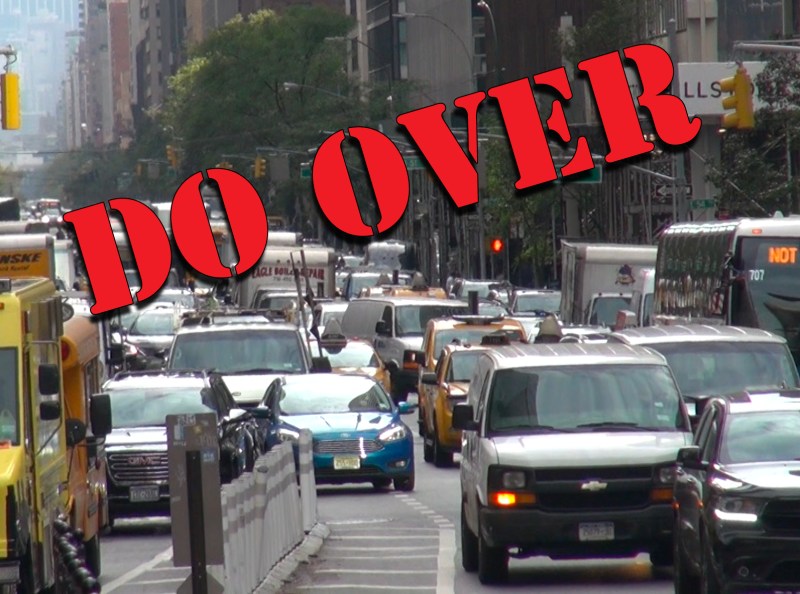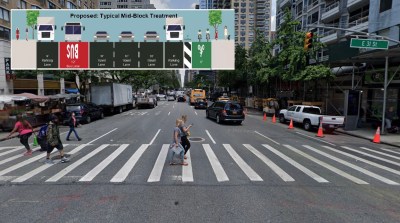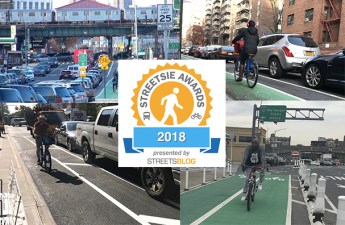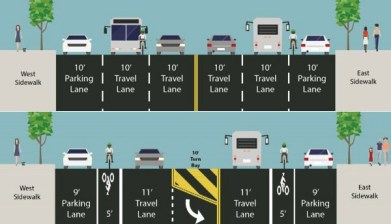TONIGHT! City Will Unveil Long-Awaited Third Ave. Redesign to Manhattan Panel

Is New York the “City of Yes” — or the city of the same old, same old?
We’ll find out tonight when the Department of Transportation presents its plans for a redesign of Third Avenue in Manhattan, the Adams administration’s first major from-the-ground-up street project — one that advocates will demonstrate whether the “City of Yes” is substance or slogan.
And Paris should be an inspiration, say advocates and experts.
“This is a big opportunity to expand this vision for reallocation of space. Look to Rue de Rivoli,” said urban planner Mike Lydon, referring to the Paris thoroughfare, where bike lanes were widened, leaving only one westbound lane for cars. “It’s an incredible center city model. Rather than just carving out one lane of space for cycling infrastructure, they flipped everything on its head. … We’re at a point where we can be taking that design approach [as] international peer cities are doing.”
Lydon offered a rendering of what the city could do (albeit on Second Avenue, but the concept applies):
Advocates and pols have long been fighting to reimagine Third Avenue — an unapologetic highway featuring seven lanes for northbound cars and trucks and nothing for bus riders or cyclists, and little sidewalk space for pedestrians — and they finally got the attention of the DOT, which announced this summer that it would draw up a safer corridor. Since 2019, there have been a whopping 703 reported crashes on just 18 blocks of Third Avenue between 24th and 42nd streets, leaving one pedestrian dead, and 198 people injured, including 40 cyclists and 63 pedestrians, according to city stats.
Those advocates won’t be pleased if the agency comes back with merely a bike lane that repurposes a mere eight feet from drivers. After all, that’s already outdated; on the First and Second avenue bike lanes, cars and trucks barely outnumber bikes, despite drivers getting almost 12 times as much space, according to a Streetfilms count last year.
So the impetus is on the city to build on the existing bike boom in a way that encourages growth, said Kate Fillin-Yeh of NACTO, the organization of city transportation officials.
“One of the big things is to build for the volumes we want. We spend a lot of time building for the volumes we have, and we end up with decent, but still-not-wide-enough lanes in a lot of places,” Fillin-Yeh recently told Streetfilms. “What we need to be doing is building for what we want to see and what we want to encourage; with the Paris example, they have built for the city they want to see, they have prioritized and made it absolutely the easiest choice to take the metro, to bike, to walk.”
Refashioning Third Avenue would have beneficial ripple effects, like helping the city meet its other goals of reducing carbon emissions, and getting people out of private cars and onto mass transit, said Lydon.
“A street redesign like that could totally hit all those goals. I think it’s a great street for that, more central to the middle of Manhattan and it doesn’t currently have any of this infrastructure,” said Lydon.
And not only would a complete street redesign offer much-needed safety benefits for the area, but it could also be a boon for business. When the city installed a protected bike lane on Skillman Avenue in Queens, some locals feared it would devastate mom-and-pop shops, but city data proves that was not the case — not only did the revenue of businesses along the commercial stretch jump by 12 percent after the lane went in in 2018, but new businesses also started opening, increasing the number of storefronts by 10 percent, Streetsblog reported using data from the Department of Finance obtained through a costly Freedom of Information request.

Transportation Alternatives has called for the portion of Third Avenue between 24th and 42nd streets to have only two lanes for cars, plus two new bus lanes, a separated bike path and a widened sidewalk for pedestrians and restaurants — a similar vision proposed by designers and architectures that was laid out in New York Magazine. And members of Manhattan Community Board 6 last summer unveiled their own plan to remake the thoroughfare between East 26th and 32nd streets — a change that would also cut the travel lanes down to two lanes.
One member of Community Board 8’s transportation committee says he hopes the city at least proposes the bare minimum so that walking and biking along the corridor is no longer a harrowing experience.
“I don’t like riding on this avenue. It’s terrifying, it’s bad,” Paul Krikler said during a July town hall hearing held by state Sen. Liz Krueger (D-Upper East Side). “We deserve much wider sidewalks so we can get around, not just comfortably, but safely.”
Krikler added this week that he’s hopeful “DOT presents at least a fully protected bike lane and ideally a busway,” and it also plans to “widen the sidewalk.”
Details will be shared at Wednesday’s 6:30 p.m. meeting of Community Board 8’s Transportation Committee. For meeting details, click here.


